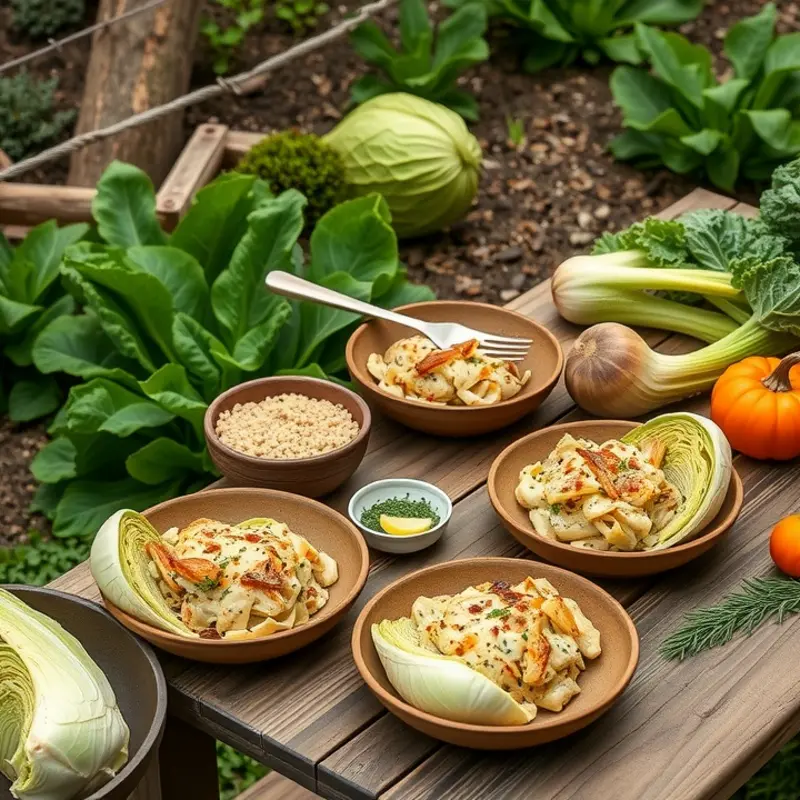Cabbage is a versatile vegetable found in diverse cuisines worldwide. Understanding its various types helps home cooks embrace their culinary creativity. Whether you’re making slaws, soups, or a simple sauté, knowing the unique characteristics of each cabbage variety can enhance your dishes. This guide focuses on practical ingredient swaps, nutritional highlights, and cooking tips tailored for anyone looking to incorporate this nutritious vegetable into their meals.
A Look at Popular Cabbage Varieties

Cabbage, with its crisp leaves and diverse varieties, serves as a culinary staple across many cuisines. Understanding the unique characteristics of different cabbage types can elevate both the nutrition and flavor of your dishes. Let’s delve into some well-loved varieties: Green, Savoy, Napa, and Red cabbage.
Green Cabbage is perhaps the most ubiquitous variety, characterized by its tightly packed pale green leaves. Its mild flavor and crunchy texture make it a versatile option for various preparations. Whether roasted, sautéed, or used raw in coleslaws, green cabbage is a reliable choice. When selecting, look for heads that are heavy for their size, with crisp, unblemished leaves. Store this hardy variety in the crisper drawer of your refrigerator, where it can last up to two weeks.
Savoy Cabbage boasts crinkled leaves and a tender texture. Its milder, slightly earthy flavor makes it well-suited for raw salads or gentle cooking methods, like steaming or stir-frying. The intricate leaf texture also holds dressings well, enhancing your salads. Choose Savoy cabbages with deep-colored outer leaves, indicating freshness. With its delicate leaves, Savoy should be stored and used within a week for optimal quality.
Napa Cabbage, also known as Chinese cabbage, offers a sweet, delicate flavor and thin, pale green leaves. Ideal for Asian dishes, it’s a star ingredient in kimchi and stir-fries. Napa’s mild nature also makes it suitable for quick pickling. Look for tightly packed heads with firm, crisp leaves. Store it wrapped in plastic in the refrigerator, where it remains fresh for about a week. For more ways to use this versatile ingredient, explore minimal-prep dinner ideas that feature cabbage.
Red Cabbage stands out with its vibrant hue and peppery notes. Rich in antioxidants, it’s both visually appealing and nutritious. Cooking methods like braising mellow its sharpness, making it an ideal accompaniment to heavier dishes. It’s also an excellent choice for raw slaws, adding a pop of color to any plate. Select red cabbages that feel firm and dense, avoiding any cracks or browning. Store in the fridge to maintain its vibrancy and texture.
To maximize freshness across all types, follow eco-smart kitchen storage habits, reducing waste and keeping your cabbages at their best. As you explore these varieties, tailor your choice to the cooking method and flavors you wish to emphasize. Each type of cabbage presents unique opportunities to bring both health and flavor to your table.
Cooking Techniques and Substitutions

Unlock the culinary potential of cabbage by exploring versatile cooking techniques that suit each variety. Braising is a method where cabbage truly shines. For varieties like Savoy and Napa, braising brings out a lush texture and rich flavor. Sauté thinly sliced cabbage with aromatics, then add a splash of broth. Cover and cook until tender, allowing the cabbage to retain a slight bite.
For those with a penchant for fermented flavors, consider making sauerkraut or kimchi. Green cabbage serves as the backbone for traditional sauerkraut, while the spicy nuances of Korean kimchi are best achieved with Napa cabbage. Fermenting extends shelf life and enhances nutritional value, boosting probiotics without needing dairy-focused cultures. You can learn more about non-dairy probiotics here.
Adding cabbage to healthier meals is simpler than it seems. Thinly sliced red cabbage can add a vibrant crunch to salads, slaws, or grain bowls. Combine it with carrot shavings and a light vinaigrette for a color contrast that is as appealing visually as it is to your taste buds.
For those exploring the world of culinary substitutions, cabbage offers flexibility. Green cabbage leaves can sometimes replace lasagna sheets in layered dishes, particularly for gluten-free or low-carb adaptations. Just boil or steam the leaves until pliable, then use as you would pasta.
Another innovative substitution comes from cabbage “steaks.” Using a dense variety like white cabbage, cut into thick slices and roast until caramelized on the edges. These can serve as a hearty base for sauces or a unique main course resembling grilled steak.
Regardless of the method, it’s essential to utilize proper storage techniques to maintain cabbage’s freshness, aligning with smart kitchen practices. Storing cabbage in a cool, dark place helps preserve its crispness and nutritional profile. Consider exploring eco-smart kitchen storage strategies to minimize waste.
By mastering these simple techniques and substitutions, you can not only expand the meal possibilities but also ensure that cabbage becomes a delightful staple in your culinary repertoire.
Final words
Cabbage is not just a staple; it’s a versatile ingredient that complements a variety of dishes and cooking styles. By understanding the various cabbage types and their unique qualities, home cooks can elevate their meals with ease. From crunchy slaws to warming soups, cabbage can adapt to fit any culinary need. Embrace this nutritional powerhouse, experiment with its flavors, and enjoy the health benefits it offers. Your journey with cabbage has just begun—explore its diversity and get creative in the kitchen!







